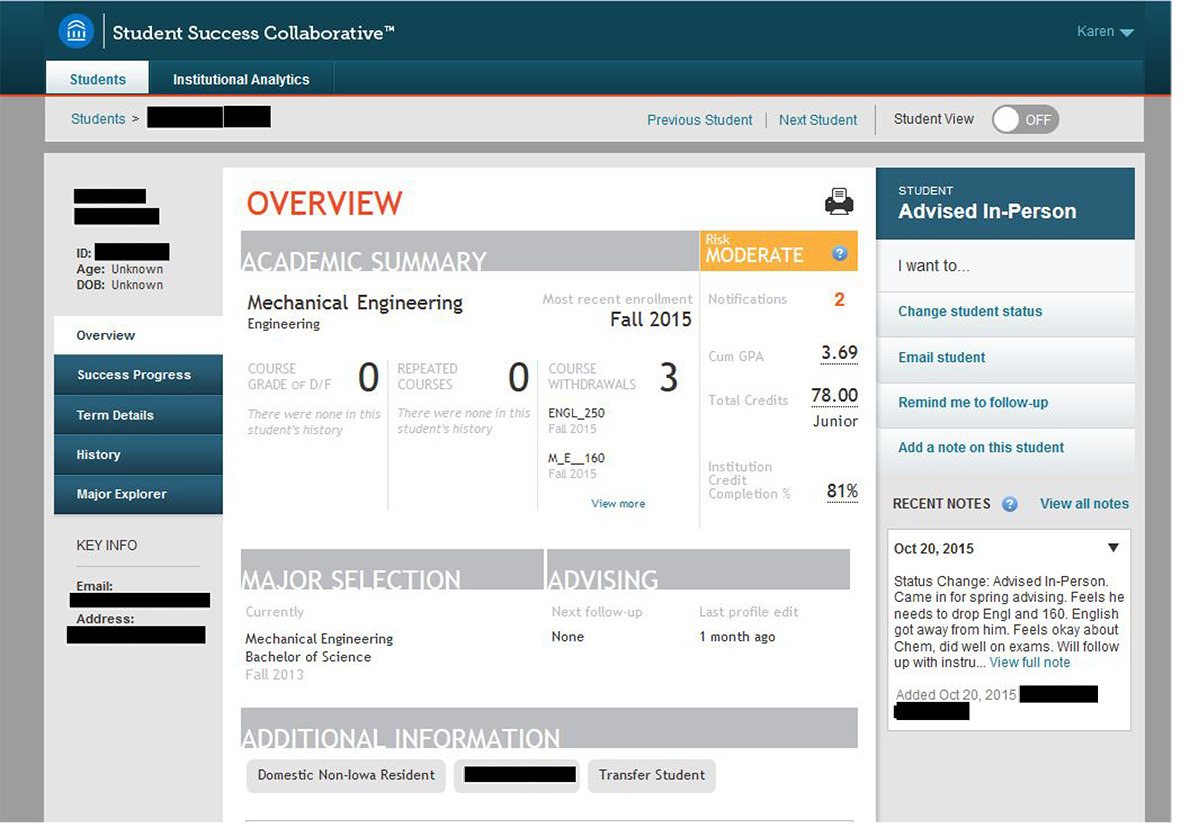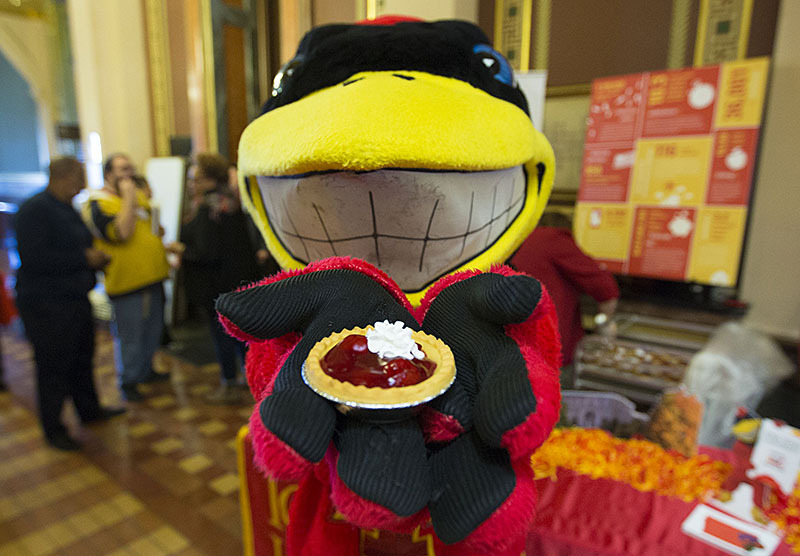Over the past decade, 82 percent of Iowa State mechanical engineering majors who earned an A in Math 166 (calculus II) and 80 percent who earned a B went on to graduate in ME. The odds were longer for those less adept in calculus. Students who managed a C had a 64 percent chance of netting an ME degree. Among those who got a D and ended up retaking the course, 43 percent eventually graduated in ME.
Pilot participants 2015-16
- College of Design
- Horticulture
- Geological and atmospheric sciences
- Food science and human nutrition
- Kinesiology
- Mechanical engineering
- Undeclared engineering
- Liberal Arts and Sciences college advising, includes open option, pre-health, biological and premedical illustration majors
Since last fall, advisers in the mechanical engineering department and seven other academic areas have been using these kinds of statistical insights to keep better tabs on their advisees' progress and, especially, to identify students who may be struggling.
Predictive analytics refers to using big data to anticipate the odds of certain things happening in the future. At Iowa State, a small group of advisers are using analytics to assess students' chances of successfully completing their degree programs.
So far, results look promising, said Karen Zunkel, director for undergraduate programs and academic quality.
"We're still learning. It's a pilot program," she said. "But advisers are seeing positive uses for the data analytics."
Advisers across campus will get a chance to try predictive analytics in fall 2016, when the initiative is extended to all undergraduate programs.
How advising analytics works
Predictive analytics starts with number crunching, Zunkel said. Iowa State uses the Education Advisory Board (EAB), a Washington, D.C.-based firm, to sift through 10 years of ISU data, mining for markers that seem the most predictive of success. Typical markers might include a student's grades in specific classes, his or her cumulative GPA and credits earned so far.
Mostly, those markers turn out to be grades achieved in previous ISU courses. For example, the numbers show that over the past decade:
- 57 percent of ISU dietetics students who earned B's in FSHN 167 (introduction to human nutrition) earned dietetics degrees
- 62 percent of kinesiology majors who booked C's in Biol 255 (fundamentals of human anatomy) attained kinesiology degrees
- 64 percent of open option students who got B's in English 250 (written, oral, visual and electronic composition) graduated with an Iowa State degree
After EAB runs the numbers, department members review the data and identify the success markers for their students, Zunkel said. Essentially, department faculty and advisers are determining what's "on track" and what's "off track" for students.
In the case of mechanical engineering data, department members decided that advisers would receive a notification on a student's advising platform if he or she didn't earn at least a C in Math 166.

View sample overview of advising platform
The EAB online advising platform includes:
- Basic student info (GPA, grades, coursework)
- A dashboard that shows at a glance who's thriving and who's struggling
- A way to create customized lists of advisees who may need special attention based on different factors (for example, all students who didn't achieve a certain grade in a prerequisite course)
- Electronic notekeeping
Early warning for advisers
Kelsey Smyth, former adviser in the College of Engineering and current university academic advising coordinator in the Center for Excellence in Learning and Teaching, said predictive analytics is "a nice addition to advisers' gut instincts.
"It helps them get to know their advisees -- especially those who don't drop by the office much -- a little better and a little earlier," she added.
"If we know a little bit sooner that students might be in trouble academically, we can hopefully get them into the office, do a little digging and push them to take advantage of resources and improve study skills. We can also make sure they understand how important certain foundation classes are to their future coursework."
"For really experienced advisers, a lot of this is commonsense," Zunkel said. "However, for new advisers who don't have 20 years of experience, it brings them up to speed faster.
"Advising analytics also is a useful tool for students who are thinking about changing majors," Zunkel added. "Advisers can say, 'Based on your courses and background, this is a major in which you would likely find success.'"
ISU leaders
ISU leaders in predictive analytics and UIA activities
Universities launch four-year analytics study
Iowa State's analytics project dovetails nicely with the work of the University Innovation Alliance (UIA), 11 universities that joined forces in fall 2014 to try to increase graduation rates for first-generation, low-income students. To achieve their goal, Iowa State and the other public research schools pledged to collaborate extensively and share ideas.
The first major collaboration among the universities is a federally funded study of analytics-based advising. Last September, the UIA received an $8.9 million U.S. Department of Education grant to do a study of the impact of analytics-based advising on student success. The study is led by Georgia State University, Atlanta, where data-driven advising has resulted in a dramatic increase in graduation rates. All UIA universities will participate in the four-year study.
Success specialists to be hired
The bulk of Iowa State's portion of the federal funds ($710,000) will be used to hire three "student success specialists," who will begin work this spring and serve three-year terms, Zunkel said. The specialists will work with first-generation or low-income students. They'll help academic advisers, "who are always stretched for time," identify at-risk students and give them some extra attention.
UIA connections
While predictive analytics is on the front burner at present, the UIA universities regularly collaborate and share notes on other ideas to improve undergraduate success, said Kathleen Gillon, who serves as Iowa State's inaugural Innovation Fellow. Topics include such things as improving the first-year experience, raising student performance in traditionally difficult courses and developing high school-to-college bridge programs. To keep the discussion flowing, every university in the alliance has a UIA fellow.
The universities also frequently send small teams of colleagues to visit each other's campuses. Thus far, teams have visited Georgia State University, Atlanta; Arizona State University, Tempe; University of Texas, Austin and Ohio State University, Columbus.
"We're constantly sharing practices, policies, successes and failures," Gillon said. "Our common goal is to collaborate so that ultimately more students across the country, especially low-income and first-generation students, not only enter college but ultimately graduate.
"The alliance schools are doing good work, but we’re constantly asking, 'How can we do better?' We’ve already seen how data analytics has positively impacted undergraduate retention and graduation at some of the alliance schools. We’re lucky to be working with a consortium of really amazing institutions that are willing to share."
More information
For more information about the alliance, contact Gillon, kgillon@iastate.edu, 294-1965. For information about predictive analytics, contact Zunkel, kzunkel@iastate.edu, 294-7063 or Smyth, ksmyth@iastate.edu, 294-2611.

